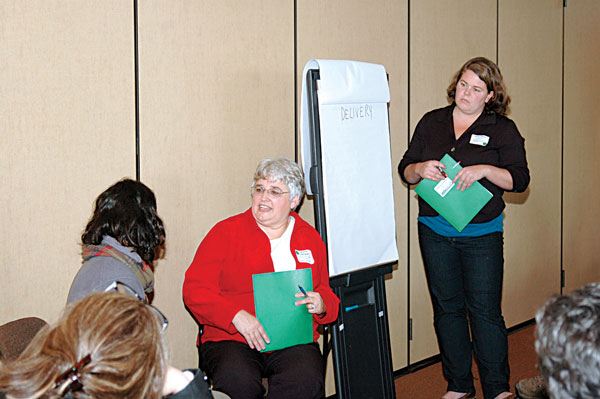by MATTHEW NASH Sequim Gazette
Out go the processed foods and in come more locally grown, organic foods.
That’s part of the mindset of advocates and organizers of the North Olympic Peninsula Farm-to-Cafeteria conference.
On Nov. 5, more than 150 farmers and officials representing schools, government and health care met in Blyn for the conference. Local farmers and parent groups organized the event to promote use of Clallam and Jefferson counties’ foods in area schools.
“I feel like we did a great job of increasing awareness on how farm-to-cafeteria programs help communities and kids,†said Beth Loveridge, co-organizer for the event.
John Bridge, a Sequim school board member, said he got the impression there are a lot of people who want better and more local food.
“It’s my goal to get with others to see how we can do the same as them,†he said.
Bridge saw another advantage to using local foods for the 1,800 children who eat school meals in the Sequim School district.
“We are feeding a lot more low-income children, so I ask, ‘Why don’t we feed them better?’†he said.
“A lot of them don’t have the resources to eat (healthier), but we can do it.â€
Baby carrots and steps
Sequim schools’ Sodexo food director Laurie Campen and George Hulett, Sodexo area manager, said the cafeterias have partnered with local farms before, specifically with Nash’s Organic Produce and Cameron’s Berry Farm.
“The issue is when you involve more than a few farmers,†Hulett said.
Several buyers in the “A Dialogue between Buyers and Sellers†group expressed concern about dealing with multiple food suppliers because that requires numerous phone calls; currently most orders can be made with one call and/or click on the Internet.
“If there was one person as a liaison between us and them, then it would save the farmers and us a lot of time,†Campen said.
She has set up a meeting with officials from Nash’s to see where the two can partner again.
Campen listed carrot sticks and cabbage as options.
“We are going to go season by season,†she said.
“It’s a good thing for both of us, the school community and the kids. We want to see this work.â€
Hulett said it’s about “baby steps†with farms to get produce into Sequim schools.
“We buy a lot of Washington-state produce already, but I understand that people want more localized, Clallam County-based foods in their schools.â€
Grass-roots beginnings
Darci Ulin, Greywolf Elementary School Parent Teacher Association president, echoed Hulett’s thoughts on going slow initially.
“I’d like to see us starting small and featuring seasonal produce and see how attendance and test scores have been affected after a certain date,†she said.
Presentations at the conference included reports of improved test scores, better attendance and behavior in classrooms after meal changes.
School districts on Lopez Island and in Olympia mandated higher nutritional values including large amounts of local produce and have seen results.
In Olympia, they’ve eliminated sugary desserts, food additives such as hormones and processes such as hydrogenation and deep fat frying and placed strict standards for beverages.
Liz Varvaro, food service director for the San Juan School District in Friday Harbor, said after two years of incorporating a food-to-cafeteria program, 82 percent of their food products come from local vendors and 19 percent directly from local farms. They serve about 450 children a day, while remaining financially stable and revenue neutral.
“It’s greatly affected our local vendors,†Varvaro said.
Ulin sees great potential in promoting the program for Sequim, too.
“It’s important to promote our local economy because the local farms are one of our natural resources,†she said.
“If we have a strong school structure, it will attract health care providers who will want to be here already. This creates incentive.â€
Viable options
In the buyers/ sellers group, they came up with short-term goals to work together such as:
• Assessing schools’ demand for local produce
• Integrating products that don’t need to be processed, such as apples
• A challenge once a month to have a local food menu option
“We made some steps and there’s going to need to be follow-through with everyone,†Loveridge said.
“Let your school boards and officials know how interested you are in this.â€
For more information and/or to become an advocate for the farm-to-cafeteria program, contact Beth Loveridge at farmtocafnow@yahoo.com or go to www.clallamgrown.org or www.jeffersongrown.org.
Reach Matthew Nash at mnash@sequimgazette.com.



